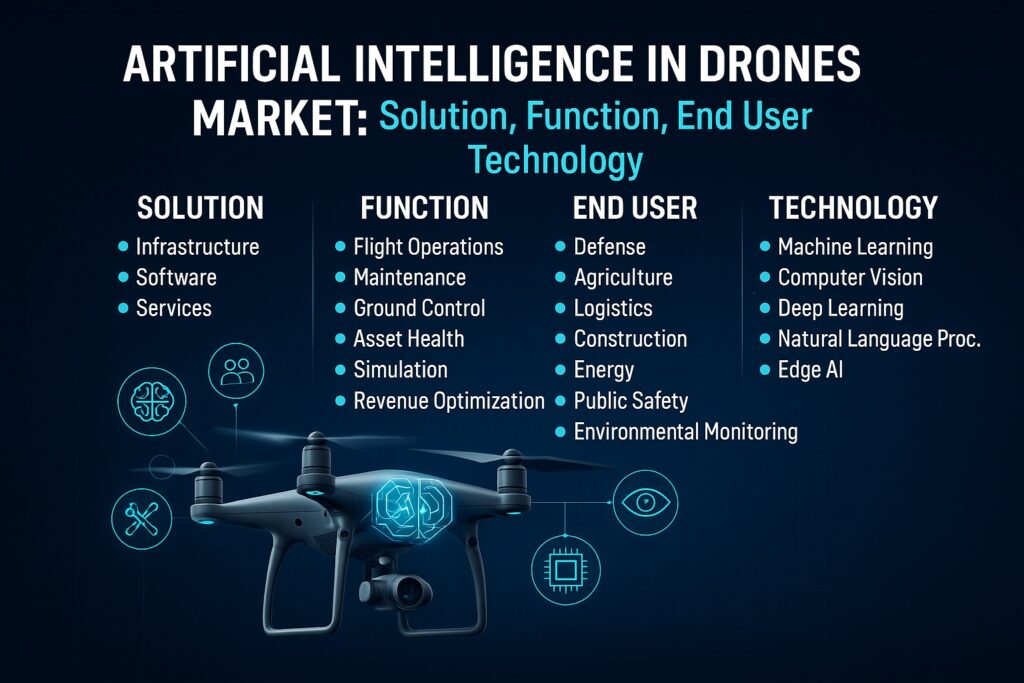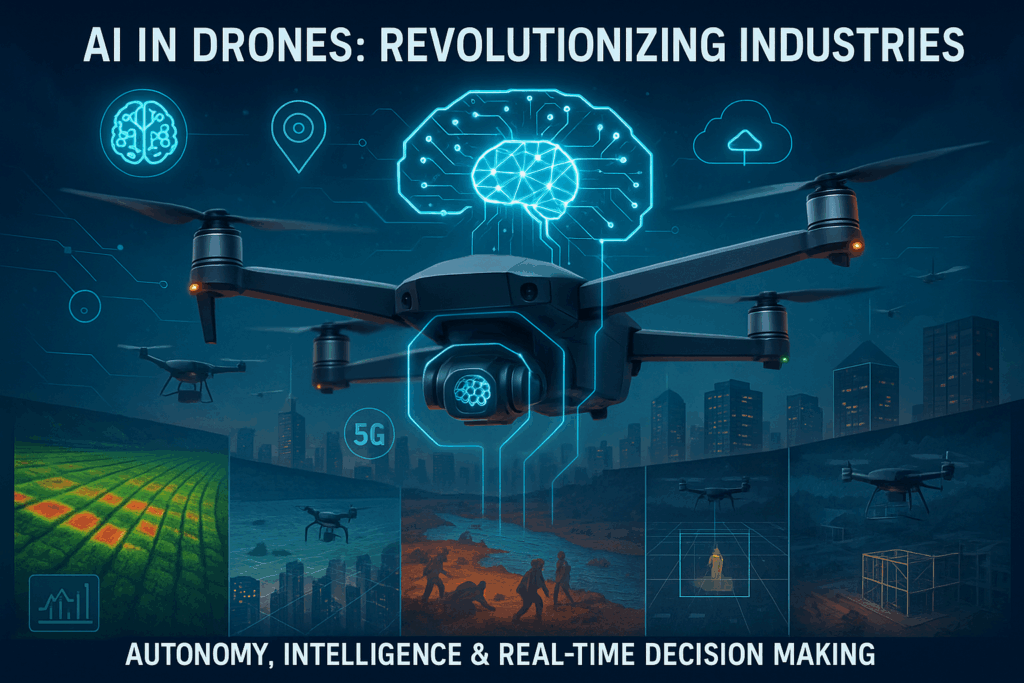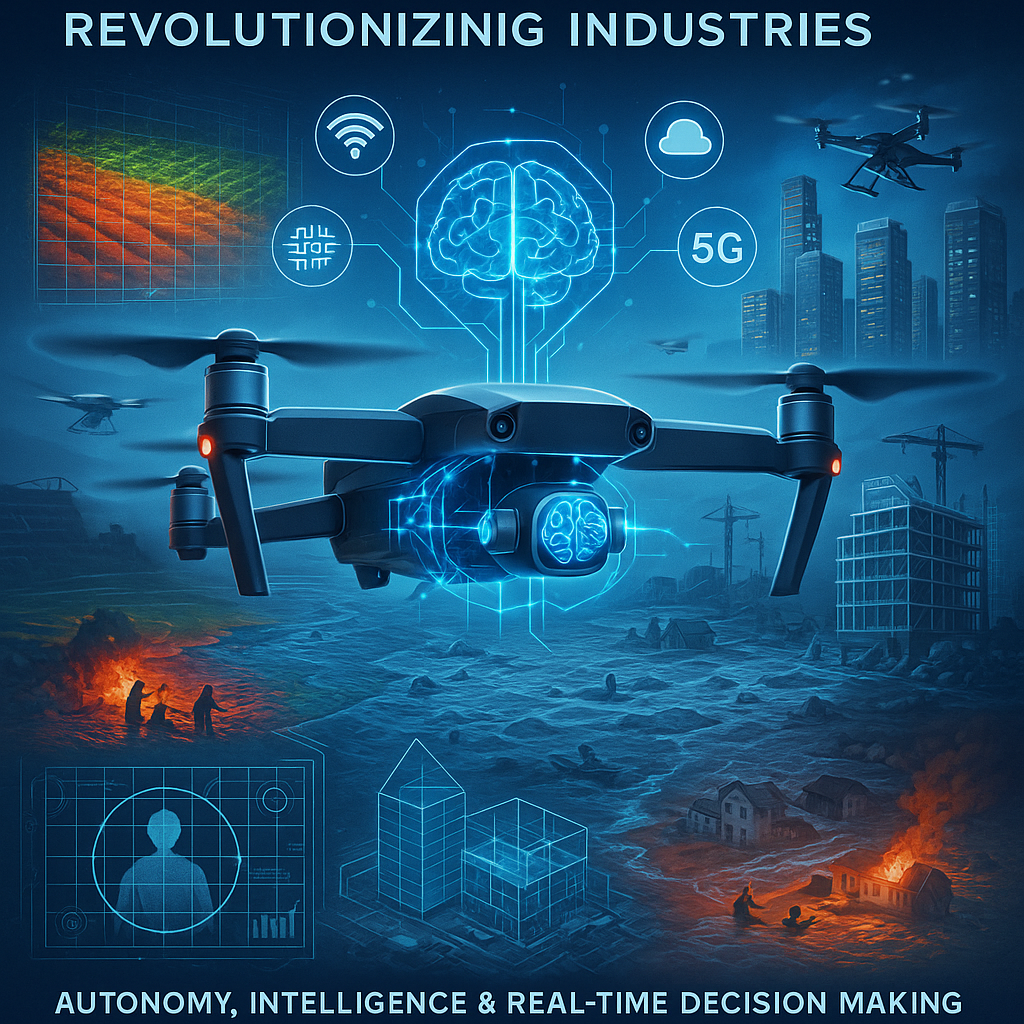The Rise of Intelligent Drones
The convergence of Artificial Intelligence (AI) and drone technology is creating a paradigm shift in the aerospace, defense, agriculture, logistics, and infrastructure industries. AI not only enhances the capabilities of unmanned aerial vehicles (UAVs) but also enables them to execute complex tasks with minimal human intervention. From real-time obstacle avoidance and autonomous navigation to predictive maintenance and fleet optimization, AI-driven drones are transforming how we perceive aerial intelligence.
Download PDF Brochure:
https://www.marketsandmarkets.com/pdfdownloadNew.asp?id=43722301
The global AI in Drones Market is witnessing rapid growth, fueled by rising demand for automation, smart analytics, surveillance, and delivery systems. As organizations across sectors invest in drone technologies, the integration of AI across solutions, functions, and technologies is redefining the UAV landscape.

Market Segmentation Overview
The AI in drones market is categorized into:
- Solution: Infrastructure, Software, and Services
- Function: Flight Operations, Ground Control, Asset Health Monitoring, Simulation, Revenue Optimization, and Maintenance
- Technology: Computer Vision, Machine Learning, Deep Learning, Natural Language Processing (NLP), and Edge AI
- End User: Defense, Agriculture, Construction, Logistics, Energy, Public Safety, and Environmental Monitoring
This article explores each segment to provide an in-depth understanding of how AI is revolutionizing drone operations and industry applications.
AI in Drones by Solution
1. Infrastructure
Infrastructure includes physical components like onboard AI chips, sensors, communication modules, and edge computing systems. With increasing demands for real-time decision-making, drones are being equipped with powerful hardware like:
- NVIDIA Jetson and Intel Movidius chips for edge AI processing
- Advanced LIDAR and RADAR systems for 3D spatial awareness
- High-resolution cameras and thermal sensors for precision imaging
These infrastructure components enable drones to operate autonomously in complex environments, avoid obstacles, and gather data in real time — all without relying heavily on remote servers.
2. Software
Software is the brain behind AI-powered drones, and includes:
- Flight management systems
- Predictive analytics software
- Computer vision platforms
- Data visualization tools
- Autonomous navigation and routing systems
AI software solutions can process data on the fly, identify objects, recognize terrain patterns, and adjust routes dynamically. Integration with cloud platforms like AWS and Azure enables scalable data storage and advanced analytics for enterprise drone programs.
3. Services
Services encompass deployment, integration, training, support, and managed drone operations. Companies are increasingly adopting Drone-as-a-Service (DaaS) and AI-as-a-Service (AIaaS) models to reduce upfront investment and accelerate deployment.
Key services include:
- AI model customization
- Real-time monitoring
- Data annotation and labeling
- Software updates and optimization
This segment is growing rapidly as enterprises and governments outsource drone operations to specialized vendors.

AI in Drones by Function1. Flight Operations
AI enhances flight operations by enabling autonomous takeoff, route planning, in-flight decision-making, and landing. Drones can dynamically adjust paths based on:
- Weather conditions
- Airspace restrictions
- Unexpected obstacles
Autonomous flight control powered by AI improves safety, reduces latency, and increases operational efficiency, especially in high-stakes applications like defense surveillance or medical supply delivery.
2. Ground Control
Ground control stations are evolving with AI to facilitate:
- Fleet management
- Mission planning
- Real-time monitoring of multiple UAVs
AI enables intelligent dashboards that interpret live telemetry data and recommend proactive actions to drone operators. In swarm drone operations, a single controller can manage dozens of drones simultaneously.
3. Asset Health Monitoring
Predictive maintenance is a key benefit of AI. Machine learning algorithms analyze:
- Battery health
- Motor temperatures
- Rotor vibration
- System diagnostics
This helps identify issues before they cause drone failure, reducing downtime and maintenance costs. It also ensures regulatory compliance and operational safety in industries like oil & gas and utilities.
4. Maintenance
AI-based inspection drones are replacing human inspectors in risky environments such as:
- Wind turbines
- Power lines
- Industrial chimneys
- Bridges and dams
Using computer vision, drones can detect cracks, corrosion, and faults, allowing maintenance teams to act quickly and accurately. AI ensures faster fault detection, improves reporting accuracy, and reduces man-hours.
5. Simulation and Training
Simulation platforms using AI are essential for pilot training, testing new flight algorithms, and stress-testing autonomous systems under virtual conditions. AI-driven simulation tools provide:
- Risk-free mission rehearsal
- Scenario modeling for emergency situations
- Machine learning model training using synthetic data
This segment is expected to grow as regulations mandate drone certification and training.
6. Revenue Optimization
In commercial settings, AI in drones can optimize delivery schedules, minimize fuel/battery usage, and enhance route planning to reduce costs. For agriculture, AI models estimate crop yields and optimize input costs, directly impacting farmer revenues.
AI in Drones by Technology
1. Machine Learning (ML)
ML is the foundation of AI in drones. It enables pattern recognition, anomaly detection, object classification, and decision automation. For example:
- In precision farming, drones can classify soil types.
- In security, they can detect unusual crowd movement.
Continuous learning from historical data allows these drones to adapt to changing environments.
2. Deep Learning
Deep learning, a subset of ML, enables drones to analyze large volumes of unstructured data like images and video streams. Applications include:
- Identifying animals or people in forests
- Counting vehicles or crops
- Recognizing infrastructure damage
It is widely used in defense, search & rescue, and construction monitoring.
3. Computer Vision
Computer vision allows drones to see and interpret their environment. With AI-enabled vision:
- Drones can map terrain in 3D
- Detect object proximity
- Perform facial and license plate recognition
Real-time video analytics is vital for surveillance, crowd control, and emergency response.
4. Natural Language Processing (NLP)
Though less common in drones today, NLP is emerging in voice-controlled drone systems and communication between control centers and UAVs. In the future, NLP may help drones understand spoken commands in military or search missions.
5. Edge AI
Edge AI allows drones to process data locally rather than relying on cloud servers, reducing latency and enabling real-time decision-making. This is crucial in:
- High-speed racing drones
- Swarm drones in combat zones
- Delivery drones navigating dense urban spaces

AI in Drones by End User
1. Defense and Security
Defense is the largest adopter of AI-powered drones. Applications include:
- Border surveillance
- Reconnaissance
- Electronic warfare
- Target tracking
AI improves mission autonomy, data encryption, and threat detection. Defense budgets worldwide are increasingly earmarked for intelligent UAVs.
2. Agriculture
Agriculture drones leverage AI for:
- Crop health monitoring
- Disease and pest detection
- Irrigation planning
- Yield estimation
AI enhances sustainability and profitability by reducing input waste and optimizing harvest cycles.
3. Logistics and Delivery
AI drones are revolutionizing last-mile delivery by:
- Avoiding obstacles
- Delivering in complex urban settings
- Coordinating multiple deliveries
Companies like Amazon, UPS, and Zipline use AI to maximize delivery speed, battery usage, and customer satisfaction.
4. Construction and Infrastructure
Drones in construction use AI for:
- Site mapping and 3D modeling
- Monitoring worker safety
- Progress tracking
- Asset inspection
AI ensures compliance, enhances worker safety, and accelerates project timelines.
5. Public Safety and Disaster Management
AI drones support emergency response teams by:
- Locating survivors in disaster zones
- Mapping fire lines or flood extent
- Monitoring crowd movement in public events
They provide real-time intelligence to save lives and optimize emergency resources.
6. Environmental and Wildlife Monitoring
Environmental agencies deploy AI drones to:
- Monitor forest density and illegal logging
- Count endangered species
- Detect marine pollution
With AI, conservation efforts become more data-driven and precise.
Regional Market Outlook
North America
- The US leads in R&D and military AI drone adoption.
- FAA support for commercial drone use is driving growth.
Europe
- High adoption in precision agriculture and environmental monitoring.
- EU regulatory frameworks supporting drone traffic management.
Asia-Pacific
- China dominates manufacturing and commercial use.
- India is growing rapidly in defense and agri-tech adoption.
Middle East & Africa
- Defense and energy sectors are major drivers.
- Use in humanitarian missions is increasing.
Challenges and the Road Ahead
Despite immense promise, several challenges remain:
- Regulatory Barriers: Varying global drone laws hamper operations.
- Privacy Concerns: AI-enabled surveillance drones raise ethical questions.
- Cybersecurity Threats: AI systems are vulnerable to spoofing or hacking.
- Cost Barriers: High development costs limit SME adoption.
However, advancements in battery tech, AI model optimization, and public-private partnerships are expected to mitigate these challenges.
A Smart Sky Revolution
AI in drones is more than a technological trend it is a disruptive force reshaping aerial operations across industries. From enabling precision in agriculture to boosting combat readiness, AI enhances efficiency, safety, and real-time responsiveness.
With advancements in edge computing, machine learning, and computer vision, the future of the AI-powered drone market looks sky-high. As regulations mature and commercial viability expands, intelligent drones will become indispensable tools across the global economic and social fabric.
